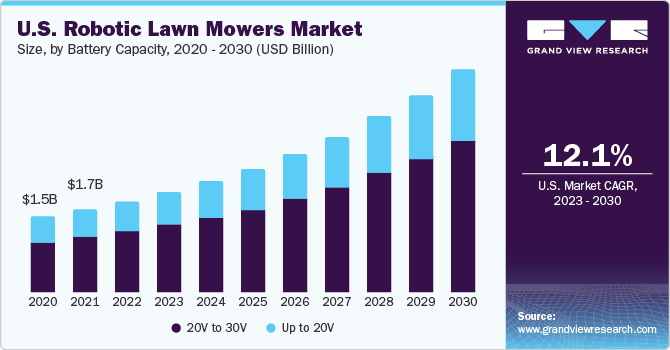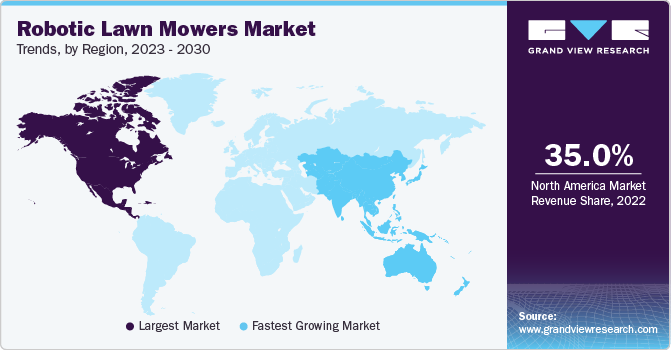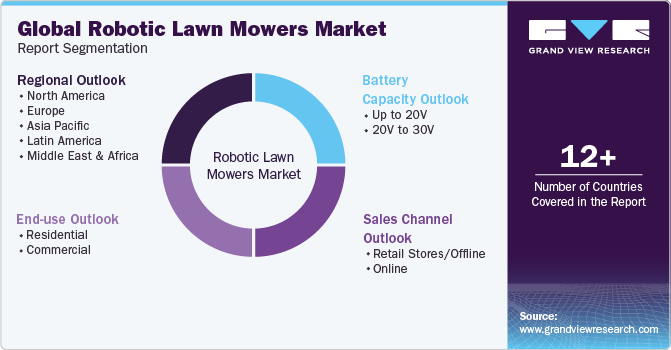- Home
- »
- HVAC & Construction
- »
-
Robotic Lawn Mowers Market Size & Share Report, 2030GVR Report cover
![Robotic Lawn Mowers Market Size, Share & Trends Report]()
Robotic Lawn Mowers Market Size, Share & Trends Analysis Report By Battery Capacity (Up To 20V, 20V To 30V), By Sales Channel (Retail Stores/Offline, Online), By End-Use (Residential, Commercial), By Region, And Segment Forecasts, 2023 - 2030
- Report ID: GVR-3-68038-624-0
- Number of Report Pages: 120
- Format: PDF, Horizon Databook
- Historical Range: 2018 - 2021
- Forecast Period: 2023 - 2030
- Industry: Technology
Robotic Lawn Mowers Market Size & Trends
The global robotic lawn mowers market size was estimated at USD 7.12 billion in 2022 and is anticipated to grow at a compound annual growth rate (CAGR) of 10.9% from 2023 to 2030. The emergence of remote-controlled and GPS-equipped autonomous lawn mowers has made gardening easier by making these products easy to track, monitor, and operate. Also, there has been a notable rise in consumer interest in gardening activities across the globe, creating an increased need for gardening tools such as robotic lawn mowers.

Growing expenditure on activities such as backyard beautification, landscaping, garden parties, and backyard cookouts, among others, along with the need to save time spent on lawn maintenance activities, are expected to drive the demand for gardening tools. The market is also driven by factors such as the growing construction and tourism industries, coupled with the increasing disposable income of individuals across the globe. Moreover, growing consumer preference toward energy-efficient products and the growing popularity of autonomous products is also anticipated to impact the global demand for robotic lawn mowers positively.
Consumers in countries such as the U.S., Germany, and the UK are significantly investing time and money in improving their gardens, yards, and lawns. This consumer approach is apparently increasing demand for smart lawn care products that save time, money, and energy. Thus, high consumer spending on landscaping activities is anticipated to drive the growth of the market.
Robotic mowers are programmed to follow efficient and precise cutting patterns. Unlike traditional mowers that tend to create uneven patches, the consistent cutting patterns of robotic mowers promote healthier grass growth. This improved lawn health reduces the need for excessive chemical inputs such as fertilizers and pesticides, contributing to a more environmentally friendly lawn care approach.
The market encounters a significant challenge due to the significant initial cost associated with these machines. Robotic lawn mowers' advanced features and capabilities include remote control via smartphone apps, automatic scheduling, and integration with smart home ecosystems. These features enhance user convenience but require additional components and engineering effort, contributing to higher product costs. However, this elevated cost can deter potential consumers, particularly those prioritizing budget considerations. Consumers who are price-sensitive may opt for more affordable traditional mowers. As a result, such factors challenge the growth of the market.
Battery Capacity Insights
Based on battery capacity, the 20V to 30V segment accounted for the largest revenue share of over 68.0% in 2022. Batteries in the 20V to 30V range predominantly feature in robotic lawn mowers used commercially. These relatively costlier products are often employed for mowing lawns that are 1.0 to 2.5 acres in size, often found in commercial areas such as sports/golf fields or the hospitality sector. The segment provides ample power to navigate various terrains, handle taller grass, and operate for extended periods between charges. Moreover, battery innovations have led to faster charging times and longer overall lifespans, addressing downtime and maintenance cost concerns. With app-based controls, GPS mapping, and automated scheduling, users can manage their lawn maintenance remotely effortlessly.
Up to 20V segment is anticipated to grow at a considerable growth rate over the forecast period. This is attributed to the rising usage of automated lawn mowers in residential applications. Up to 20V robotic lawn mowers are expected to become increasingly popular due to their eco-friendly and efficient operation. Up to 20V robotic lawn mowers offer extended operation times, covering larger areas on a single charge.
Sales Channel Insights
Based on sales channels, the retail stores/offline segment accounted for the largest revenue share of over 57% in 2022. The increasing demand for time-saving and convenient solutions has pushed traditional retail stores to embrace robotic lawn mowers. These devices cater to homeowners seeking effortless lawn maintenance, urge to a wide demographic ranging from busy professionals to elderly individuals who may find traditional mowing physically challenging. The sector's success is intrinsically tied to consumers' demands for convenience, variety, and value.
With the rise of e-commerce, consumers now expect seamless online and offline shopping experiences, pushing retailers to innovate and integrate digital technologies into their operations. Global economic conditions also significantly impact the retail sector. Economic factors such as GDP growth, inflation rates, and consumer confidence influence consumer spending patterns. During economic downturns, consumers often become more price-conscious and turn to discount retailers, while in times of prosperity, luxury and specialty stores tend to thrive. Moreover, geopolitical factors, trade policies, and supply chain disruptions can disrupt the flow of goods, affecting inventory management and pricing strategies.
The online segment is expected to register the highest growth over the forecast period. The growing trend of convenience-seeking consumers has propelled the demand for online shopping. With a few clicks, the customers can compare a wide range of robotic lawn mower models, features, and prices from their homes. One of the primary drivers is the widespread adoption of digital technologies and the increasing accessibility of the internet, which has connected billions of people worldwide. This connectivity has enabled consumers to shop conveniently from the comfort of their homes or mobile devices, thereby fuelling the demand for online shopping platforms. Another crucial factor propelling the e-commerce sector is the convenience and personalized shopping experiences offered by these platforms. Online retailers leverage sophisticated algorithms and data analytics to understand customer preferences, recommend products, and tailor marketing efforts, enhancing customer satisfaction and loyalty. In addition, the COVID-19 pandemic accelerated the shift towards online shopping as lockdowns and safety concerns prompted consumers to rely heavily on e-commerce for their everyday needs, further boosting the sector's growth.
End-use Insights
Based on end-use, the residential sector segment accounted for the largest market share of over 56% in 2022. The increasing demand for convenience and time-saving solutions has led homeowners to seek automated alternatives for lawn maintenance. Robotic lawn mowers offer the advantage of hands-free operation, allowing homeowners to delegate the time-consuming task of mowing to a machine while they focus on other activities.

The commercial sector is expected to register considerable growth over the forecast period. Rising government investment into improving existing infrastructure, parks, and lawns near historic monuments is anticipated to drive the demand for robotic lawn mowers in the commercial sector. Also, the segment is also expected to witness significant growth over the forecast period owing to the steady growth of the hospitality and tourism industries.
Regional Insights
North America dominated the market with a revenue share of over 35.0% in 2022. Busy lifestyle patterns resulted in end users' approach towards automating lawn maintenance activities. Robotic lawn mowers offer the convenience of hands-free operation, allowing users to allocate their time to more important activities. Innovations in sensors, artificial intelligence, and GPS navigation systems enable robotic lawn mowers to navigate and maintain lawns of varying sizes and complexities efficiently.

Asia Pacific region is expected to register the highest CAGR over the forecast period. In the Asia Pacific, the rapid urbanization and increasing affluence across countries have led to a rise in demand for smart and convenient home solutions. Robotic lawn mowers align with this trend by offering an automated and hassle-free way to maintain outdoor spaces, saving homeowners time and effort. Countries such as Japan, South Korea, and China have been at the forefront of robotics and automation, fostering a favourable environment for developing and deploying cutting-edge technologies.
Key Companies & Market Share Insights
Market players are engaging in several growth strategies, including mergers & acquisitions, partnerships, collaborations, and geographical expansion, to stay afloat in the competitive market. The competitiveness is anticipated to intensify further as many companies focus on expanding their product portfolio by introducing advanced features or technologies in their existing product lines. For instance, in July 2023, Aquark Technology Limited showcased a robotic lawn mower named Mr. Silence at spoga+gafa2023, a garden and lifestyle expo held in Germany. Moreover, in October 2022, Husqvarna AB (publ) launched a virtual boundary robotic lawn mower named Automower NERA for private gardens. This range can deploy with an accuracy of 2-3 centimeters and take on rough slopes and terrain with up to 50% inclination. This lawn mower operates without any physical boundary wires, and it is complemented by a Husqvarna EPOS (Exact Positioning Operating System) plug-in kit, marketed as an independent accessory.
Key Robotic Lawn Mowers Companies:
- AL-KO
- Belrobotics
- Deere & Company
- Flymo
- HONDA MOTOR CO., LTD.
- Husqvarna Group
- Robert Bosch GmbH
- Robomow Friendly House
- STIGA S.p.A.
- WIPER S.R.L.
- Worx
Robotic Lawn Mowers Market Report Scope
Report Attribute
Details
Market size value in 2023
USD 7.75 billion
Revenue forecast in 2030
USD 15.94 billion
Growth rate
CAGR of 10.9% from 2023 to 2030
Base year for estimation
2022
Historical data
2018 - 2021
Forecast period
2023 - 2030
Quantitative units
Revenue in USD million/billion and CAGR from 2023 to 2030
Report coverage
Revenue forecast, company ranking, competitive landscape, growth factors, and trends
Segments covered
Battery capacity, sales channel, end-use, region
Regional scope
North America; Europe; Asia Pacific; Latin America; MEA
Country scope
U.S.; Canada; UK; Germany; France; Italy; Spain; China; India; Japan; Australia; South Korea; Brazil; Mexico; Argentina; U.A.E.; Saudi Arabia; South Africa
Key companies profiled
AL-KO; Belrobotics; Deere & Company; Flymo; HONDA MOTOR CO., LTD.; Husqvarna Group; Robert Bosch GmbH; Robomow Friendly House; STIGA S.p.A.; WIPER S.R.L.; Worx
Customization scope
Free report customization (equivalent up to 8 analysts working days) with purchase. Addition or alteration to country, regional & segment scope.
Pricing and purchase options
Avail customized purchase options to meet your exact research needs. Explore purchase options
Global Robotic Lawn Mowers Market Segmentation
The report forecasts revenue growth at global, regional, and at country level and provides an analysis of the latest trends in each of the sub-segments from 2018 to 2030. For this study, Grand View Research has segmented the global robotic lawn mowers market report based on battery capacity, sales channel, end-use, and region:

-
Battery Capacity Outlook (Revenue, USD Million, 2018 - 2030)
-
Up to 20V
-
20V to 30V
-
-
Sales Channel Outlook (Revenue, USD Million, 2018 - 2030)
-
Retail Stores/Offline
-
Online
-
-
End-use Outlook (Revenue, USD Million, 2018 - 2030)
-
Residential
-
Commercial
-
-
Region Outlook (Revenue, USD Million, 2018 - 2030)
-
North America
-
U.S.
-
Canada
-
-
Europe
-
U.K.
-
Germany
-
France
-
Italy
-
Spain
-
-
Asia Pacific
-
China
-
India
-
Japan
-
Australia
-
South Korea
-
-
Latin America
-
Brazil
-
Mexico
-
Argentina
-
-
Middle East & Africa (MEA)
-
U.A.E.
-
Saudi Arabia
-
South Africa
-
-
Frequently Asked Questions About This Report
b. The global robotic lawn mowers market size was estimated at USD 7.12 billion in 2022 and is expected to reach USD 7.75 billion in 2023.
b. The global robotic lawn mowers market is expected to grow at a compound annual growth rate of 10.9% from 2023 to 2030 to reach USD 15.94 million by 2030.
b. North America dominated the robotic lawn mowers market in 2022 with a share of over 35.0%. Busy lifestyle patterns resulted in end users' approach towards automating lawn maintenance activities.
b. Some key players operating in the robotic lawn mowers market include Deere & Company, American Honda Motor Co., Inc., Robert Bosch GmbH, STIGA S.p.A., Robomow Friendly House, and Husqvarna Group.
b. Key factors that are driving the robotic lawn mowers market growth include increased expenditure on activities such as landscaping, backyard beautification, backyard cookouts, and garden parties, along with the need to save time spent on lawn maintenance activities.
Share this report with your colleague or friend.
![gvr icn]()
NEED A CUSTOM REPORT?
We can customize every report - free of charge - including purchasing stand-alone sections or country-level reports, as well as offer affordable discounts for start-ups & universities. Contact us now
![Certified Icon]()
We are GDPR and CCPA compliant! Your transaction & personal information is safe and secure. For more details, please read our privacy policy.
We are committed towards customer satisfaction, and quality service.
"The quality of research they have done for us has been excellent."





